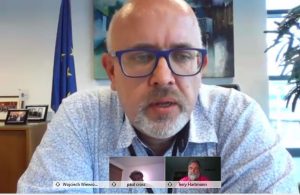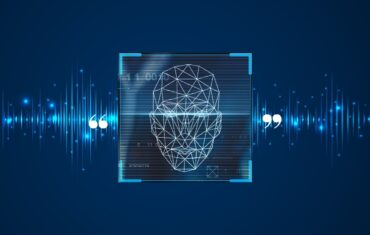It’s the first year we’ve held the Biometrics Institute Congress online and what a success it was. The A-Z of biometrics through brilliant debates, insightful presentations and honest discussions in eight sessions across the month of October.
Through these important discussions, the task ahead is clear. We need to define what good looks like and be transparent about our processes. Transparency is the only way to build trust into the business of biometrics.
In our 21 October session, we asked delegates, ‘Has the biometrics community done enough to influence the message on the ethical use of facial recognition?’ A resounding 77% said no.
So no sooner did Congress close its virtual doors than we are making plans to continue the trusted and diverse conversations on the responsible and ethical use of biometrics to enable you to better serve the people who rely on the decisions you make. We’ll be updating you on our new upcoming events soon.
Please read on for a wrap up of each day of Congress, but here are the key themes that ran through all eight sessions:
- Technology is moving fast, policy and processes cannot keep up, nor do standards
- What limitations are there in biometrics and how can they be addressed?
- Testing is critical
- Better education of the public and of decision-makers is essential
- We need to build trust amongst the public and address the fear of surveillance
- Trust is key and transparency is key to trust
- The world of travel has changed and the implications of contactless, hygiene and masks have to be addressed
- The importance of the human in the loop
- The future is digital, but is convenience the key driving factor for biometrics in digital ID?
“The Biometrics Institute has been able to continue the all-important conversations about the responsible and ethical use of biometrics in its online Congress by continuing to provide a trusted and collaborative platform. I have thoroughly enjoyed the exchanges with the institute members and key stakeholders.”
Jean-Philippe Morange, Coordinator Border management & Law enforcement, United Nations Counter-Terrorism Committee Executive Directorate (CTED)
Day one of the Congress… As we opened Congress we launched two documents which underpinned the whole event: our Three Laws of Biometrics and our 2020 State of Biometrics Report. The Three Laws of Biometrics quickly got cited by presenters and impacted many of the conversations. The five themes of the State of Biometrics Report – topics which our expert groups identified as impacting biometrics most significantly in the coming months – ran throughout Congress. They are:
- COVID-19
- Legislative controls
- Demographic differentials
- Awareness and public perceptions
- Digital identity
Expert presenters included Wojciech Wiewiorowski, the European Data Protection Supervisor, Ken Gantt from the U.S. Department of Homeland Security, Krum Garkov, from eu-LISA, Heidrun Holin of Lufthansa and Steven Wright from the UK Information Commissioner’s Office.

Wojciech Wiewiorowski, the European Data Protection Supervisor opened Congress
In his opening keynote, Mr Wiewioroski, the European Data Protection Supervisor, acknowledged the importance of the institute’s work. He also pointed out how the system is fragile and said he supports the idea of a moratorium on the deployment of biometrics in the EU. Read his full presentation on his website here.
Ken Gantt reminded delegates how the institute had invited members to wear masks at Congress back in 2016. Was this a sign of our vision for the future?
Presenters demonstrated how technology is moving so fast and creating fear and issues of acceptance by taking us on a virtual high-speed train journey, highlighting many developments that the industry needs to address along the way.

Isabelle Moeller and Ken Gantt at the Biometrics Institute Congress in 2016
A comparison was made between the Three Laws of Biometrics and three trains that are running at different speeds: Policy, process and technology.
The day concluded with a specialist session on biometrics in border management and travel. Public perception and control of data flows were highlighted as key challenges needing attention, when technology adoption is moving as fast as a high-speed train.
Pre-clearance for health screening is going to be very important especially once borders open again. Seamless travel was all about volume and COVID-19 has changed this. In a poll, 66% of delegates said COVID-19 had forever changed the way biometrics are used and implemented.
The focus is now on rebuilding confidence and addressing hygiene and health safety. Several questions were raised such as whether the industry is taking advantage of the pandemic to advance business interests rather than providing real solutions, and whether digital identity is really a solution.
The Biometrics Institute has once again delivered on its promise of providing a trusted and open platform for discussions between diverse stakeholders on how to get biometrics right. Where else will you find a panel of opposing views discussing facial recognition questions in a constructive way with the aim of finding common ground?”
Robert Mocny, Former Director US-VISIT, US Department of Homeland Security
Day two of Congress… addressed digital ID and how to maintain customer trust in using biometrics with guests including innovation consultant David Birch, Dominic Phoon from GovTech Singapore and Samuel Stuart from Mastercard. They discussed questions like do biometrics need to be used in a digital ID framework and how can they be made culturally acceptable? Is the use of digital ID day-to-day all about authentication? And how does the argument between centralised and decentralised data storage stack up? Could or should they co-exist?

Stephanie Schuckers with Patrick Grother and guests
This was followed by a focus on testing, accuracy and performance with Stephanie Schuckers from the Center for Identification Technology Research, Patrick Grother from the National Institute of Standards and Technology (NIST) and Ralph Breithaupt from the German Federal Office for Information Security. We had an update on masks testing and also discussed that the use of synthetic data could be a real paradigm shift for testing. In our poll that day, only 3% said standardised testing wasn’t important for the industry’s future.
Our panellists asked how to successfully move experiences from the lab to the real world. The order of our Three Laws of Biometrics was cited – policy, process then technology – and it was noted that it is frequently not the technology at fault but the way humans use it.

Lindsey Chiswick from the Metropolitan Police and Gracie Bradley from Liberty were among the panelists discussing facial recognition
Congress day three… provided our members with incredibly diverse viewpoints from around the world addressing important questions of national security, counter-terrorism as well good practices for facial recognition. Michele Coninsx from UNCTED and Ed Santow, the Australian Human Rights Commissioner, joined Lindsey Chiswick from the Metropolitan Police and Gracie Bradley from Liberty.
Biometrics have their place in society, but like any technology, they can be used for good or bad. We must not forget that technology including biometrics exists to serve humans. Each use case is different and needs careful assessment whether biometrics are the appropriate and proportionate solution. The greatest fears are around the potential for mass surveillance. We asked delegates if they thought the public were right to be concerned about linked databases leading to mass surveillance. An incredible 90% said yes. It was concluded that transparency and trust are critical.
“The Biometrics Institute Congress confirms the depth and breadth of its expertise, as well as its crucial role in educating organisations and governments about the ethical use of biometrics.”
Pam Dixon, World Privacy Forum
This lead nicely into the discussion on the final Congress day focusing on how to build trust and confidence in biometrics, a session delivered by an all-female cast.
We discussed:
- The importance of transparency about processes, uses and benefits of biometric systems
- How open collaboration between all stakeholders including technologists, policymakers, lawyers, users and others who are part of the process leads to a more rounded product
- The human should be at the centre of all biometric implementations including the design, user interface and biometric outputs
- Why the consideration of human psychology is vital in biometrics – individuals want to know that that an application is going to help them, not put them at risk
- The absolute need for rigorous testing to address the limitations of the technology
And in the closing session we heard from members of our expert groups on some of the topics they will be focusing on in the coming twelve months, and more.
We are very grateful for the support of our sponsors. The virtual exhibition is still open where you can explore what some of the leading names in biometrics are working on and contact them directly for more information. So please do visit and find out more about what IDEMIA, Thales, iProov, WorldReach, Innovatrics and SITA have to offer.
If you attended, as we prepare for more online events into 2021, I’d be interested in hearing your views so we can continue to improve how you engage with other Biometrics Institute members around the world.
And if you didn’t join us but this has whetted your appetite for the full experience, contact us now to access every single session of our 2020 Congress and learn from all the brilliant conversations and diverse perspectives we’ve had across the month.
I look forward to seeing you soon – either in person or online.
Isabelle






